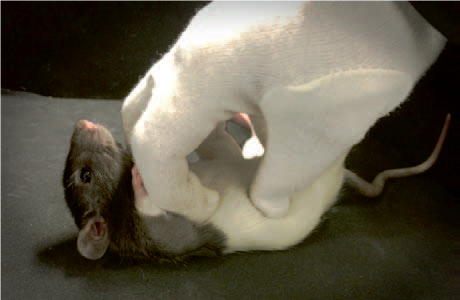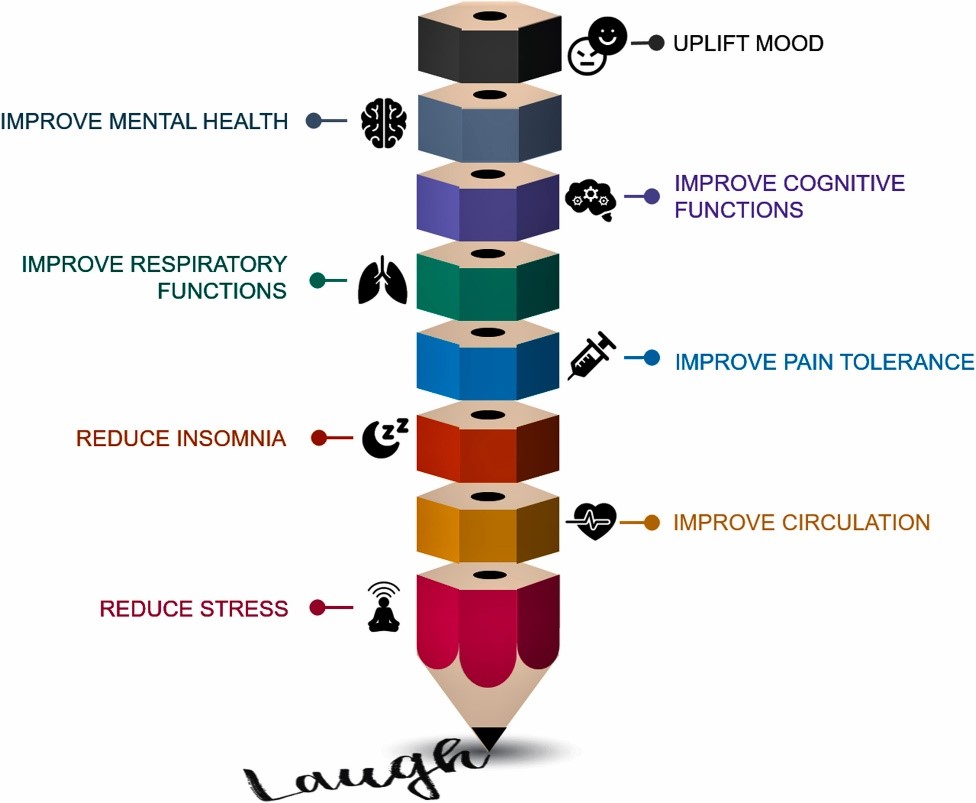Medical research nowadays mostly focuses on understanding different diseases aiming for the development of new preventive and therapeutic approaches. While this is an important aim, the work can cause emotional distress focusing mainly on the weaknesses and failures of the human body. But does it always have to be the case? Of course, not! I learned this already during my bachelor studies …
How I was introduced to tickling rats

I had my key experience in one of the bachelor seminars, in which we were talking with the supervisors about their projects. Here, one of them said: ‘I’m tickling rats!’ I first thought it was just a joke but then he replied: ‘If you want to, come and visit my lab to see yourself.’ My curiosity motivated me to follow that invitation and visit the laboratory of Michael Brecht at the Bernstein Center for Computational Neuroscience at the Humboldt University of Berlin. In his lab, I saw the unimaginable: there was a cute little rat in a small box that was professionally tickled at different parts of its body by my seminar supervisor Shimpei Ishiyama. As the tickling reaction of rats might be ultrasonic vocalizations, Shimpei used microphones and transducers in order to convert those vocalizations to a lower frequency for humans to hear them. And indeed, whenever Shimpei was tickling the back or belly of the rat it produced 50-kHz vocalizations, performed unsolicited jumps, and approached his hand for further tickling. I was really surprised and fascinated by these observations which clearly indicated pleasure and joy by the rats. (By the way, mice do not produce any vocalizations while being tickled and can therefore not be used for this kind of study.)
The science behind tickling
Similar to humans, rats prefer certain body parts such as the back and belly over the tail to be tickled. During this process, increased neuronal activity was detected in the somatosensory cortex (1). Deep-layer, but not superficial-layer, microstimulation elicited exactly the same vocalizations observed during the tickling, proposing the localization of neuronal activation to the deep layers of the somatosensory cortex being specific to tickling. Furthermore, it could be shown that self-touch-induced GABAergic inhibition in trunk somatosensory cortex suppresses vocalizations evoked by allo-touch, tickling, or cortical microstimulation thereby proposing a mechanism for why we cannot tickle ourselves (2).
Interestingly, the rat’s responses to the tickling have been shown to be mood-dependent as they were absent under anxiogenic conditions such as on an elevated platform or under bright illumination (1). Besides, these playful vocalizations were more prominent in young rats than adults. If that sounds familiar to you, you are not alone. Charles Darwin already described that young monkeys, similar to human children, enjoy being tickled – hypothesizing a link between tickling and play (3). This link could be further confirmed by Ishiyama and Brecht on a neuronal level due to the fact that the evoked neuronal activity during playing behavior, such as the rat chasing the experimenter’s hand, was similar to the activity evoked by tickling (1).

Tickling in this sense triggers laughter, which according to Darwin is “the expression of mere joy and happiness”. And here we go even one step further because tickling can now be associated with social relations and bonding. Tickling promotes social interactions by getting us to play with each other and deepen our connections and relationships. We are all well aware of this, as we perceive the situation around us as pleased and relaxed when we laugh. Laughter is also a form of communication. Already a simple smile indicates joy, happiness, and kindness, and is therefore a very common and universal empathic signal that each of us starts to automatically use at 8 weeks of age (4). Laughter occurs most often during social events as we rarely laugh ourselves, and most of the time there is not even a good reason why we laugh, we just do it for the social interaction (or because of being tickled)! In addition, laughter is very important when it comes to interpersonal skills: it indicates the social hierarchy and affiliation, provides emotional context, and direct feedback in a conversation.
The importance of studying tickling

But why are these kind of studies important to us? At the end of the day, it´s all about health and disease! Laughter can actually be considered an exercise. A famous comparison indicates that laughing 100 times is equivalent to 15 minutes of cycling, and I assume that each of us has experienced the soreness of muscles after a good laugh to confirm this statement. Studies conducted on patients with type 2 diabetes have shown that laughter can actually lower blood sugar levels and alter the gene expression of peripheral blood leukocytes, further supporting the idea of a health-promoting effect of laughter (5,6). In the field of immunology, one study linked laughter to improved Natural Killer cell activity when subjects watched a humorous video compared to a boring tourism video (7). Furthermore, laughter intervention in patients with rheumatoid arthritis resulted in a reduction in serum levels of pro-inflammatory cytokines such as IL-6 and TNF-α depending on the level of disease activity (8). The hypothalamic–pituitary–adrenal axis, which has been reported to be impaired in rheumatoid arthritis patients, might be involved in the anti-inflammatory/anti-stress response. This provides a potential mechanism of how laughter might improve the psychological and physiological condition of rheumatoid arthritis patients, highlighting its therapeutic potential.
But the most important meaning for us as PhD students is: Laughter plays a critical role in human mental health. A meta-analysis on laughter and humor therapy showed an overall beneficial effect on depression, anxiety, and sleep quality in study populations (9). Not surprisingly, laughter has been shown to increase the ‘happy-hormones’ dopamine and serotonin (10). So whenever you are in a bad mood and need some stress relief – you might want to ask somebody to tickle you 🙂 .
Darya Malko
- Ishiyama S, Brecht M (2016) Neural correlates of ticklishness in the rat somatosensory cortex. Science 354(6313):757-760. https://www.youtube.com/watch?v=1ukqZj9xWyk
- Ishiyama, S., Kaufmann, L. V., & Brecht, M. (2019). Behavioral and Cortical Correlates of Self-Suppression, Anticipation, and Ambivalence in Rat Tickling. Current biology : CB, 29(19), 3153–3164.e3.
- C. Darwin, The Expressions of the Emotions in Man and Animals (John Murray, London, 1872).
- L. O’Neill, Humanology (Gill Books, Dublin, 2018).
- Hayashi, K., Hayashi, T., Iwanaga, S., Kawai, K., Ishii, H., Shoji, S., & Murakami, K. (2003). Laughter lowered the increase in postprandial blood glucose. Diabetes care, 26(5), 1651–1652. https://doi.org/10.2337/diacare.26.5.1651
- Hayashi, T., Urayama, O., Kawai, K., Hayashi, K., Iwanaga, S., Ohta, M., Saito, T., & Murakami, K. (2006). Laughter regulates gene expression in patients with type 2 diabetes. Psychotherapy and psychosomatics, 75(1), 62–65.
- Bennett, M. P., Zeller, J. M., Rosenberg, L., & McCann, J. (2003). The effect of mirthful laughter on stress and natural killer cell activity. Alternative therapies in health and medicine, 9(2), 38–45.
- Matsuzaki, T., Nakajima, A., Ishigami, S., Tanno, M., & Yoshino, S. (2006). Mirthful laughter differentially affects serum pro- and anti-inflammatory cytokine levels depending on the level of disease activity in patients with rheumatoid arthritis. Rheumatology (Oxford, England), 45(2), 182–186.
- Zhao, J., Yin, H., Zhang, G., Li, G., Shang, B., Wang, C., & Chen, L. (2019). A meta-analysis of randomized controlled trials of laughter and humour interventions on depression, anxiety and sleep quality in adults. Journal of advanced nursing, 75(11), 2435–2448.
- Yim J. (2016). Therapeutic Benefits of Laughter in Mental Health: A Theoretical Review. The Tohoku journal of experimental medicine, 239(3), 243–249.
- Akimbekov, N. S., & Razzaque, M. S. (2021). Laughter therapy: A humor-induced hormonal intervention to reduce stress and anxiety. Current research in physiology, 4, 135–138.
